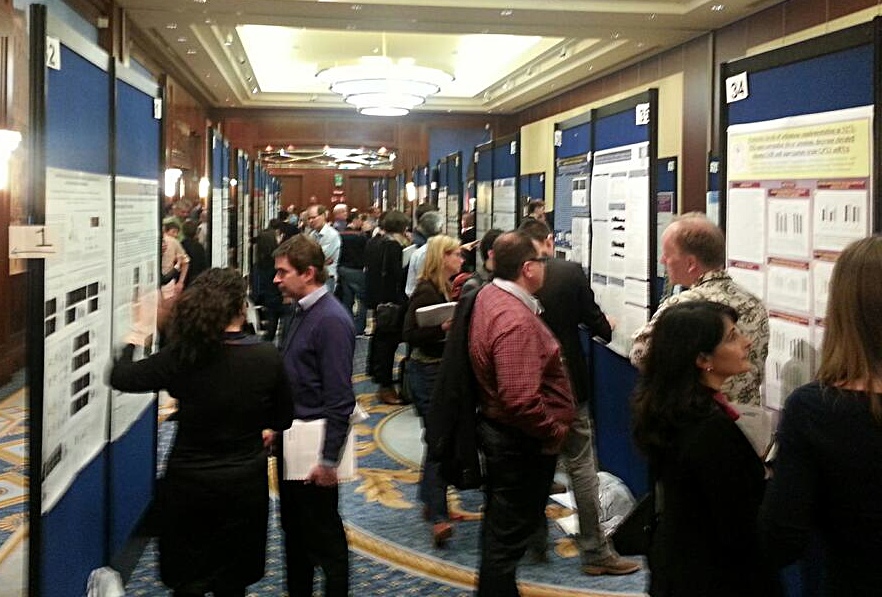
HD Therapeutics Conference 2013 Updates: Day 2
Day 2 of our coverage of the Huntington's Disease Therapeutics Conference

Our second daily report from the annual Huntington’s Disease Therapeutics Conference in Venice, Italy. You can tweet @HDBuzzFeed, comment on Facebook or use HDBuzz.net to send us questions, comments and queries.
9:09 – Good morning! Jeff and Ed will be posting updates from day two of the Huntington’s disease therapeutics conference.
9:14 – Reminder for anyone who missed it: there’s $30million in HD drug research that wasn’t there last week – see our article on the Isis and Roche deal from yesterday.

9:17 – The first session is about the huntingtin protein: what is is, what does it do and how does it cause harm?
9:26 – Dr Hilal Leshuel of EPFL, France has cool ways of making proteins in the lab so they can be played with and studied. He has used these techniques to study a crucial Parkinson’s disease protein, alpha-synuclein. He can artificially ‘tag’ his artificial proteins and see how cells handle them differently with different tags. Adding a tag called ubiquitin to the alpha synuclein prevents it sticking together into clumps (huntingtin does this too). Using techniques developed in Parkinson’s disease, his lab can now study chemical modifications of the HD protein directly. Lashuel says that simple chemical modifications of normal HD protein can make it act like mutant protein – clumping together in ‘aggregates’.
10:06 – Gerardo Morfini: HD patients have loss of ‘white matter’ in the brain, which is made of axons, suggesting it’s important to understand. Morfini is studying axons from squid! They’re huge, so much easier to work with than human or mouse axons. He has found that the mutant HD protein causes traffic jams in axons, slowing down traffic in neurons. He is looking for drugs that increase the speed of traffic in axons, combatting the effects of the mutant HD protein. Morfini wants to understand how ‘axons’ – the long part of neurons that transmit messages to other neurons – die in HD.
10:39 – James Surmeier is trying to understand which specific brain cells are the first to die in HD – what makes them so vulnerable? He is using cutting edge microscopes and techniques to study individual connections – synapses – between neurons in HD mice. He sees that communications between brain cells are improved with a drug which that is soon going to be tested in HD patients.
11:41 – Philip Gregory works with Sangamo, a company developing tools to actually edit the DNA of HD patients to remove the mutation. Gregory says that Sangamo is trying to refine their tools so that they can edit the mutant HD gene, while leaving the normal HD gene alone. Gregory says that editing mutant HD genes works in the brains of living mice, not just cells – good news for moving towards people.
12:10 – David Corey is working on new ways to “silence” the mutant HD gene. He wants to find tools for reducing levels of the mutant HD gene, while preserving the normal gene that has important functions. His team has three different chemical classes of drug that all do the same thing – help cells reduce levels of the mutant HD gene.
14:56 – We’re now in the poster session, where over a hundred cool HD projects are being presented and discussed
“Corey’s team has three different chemical classes of drug that all do the same thing – help cells reduce levels of the mutant HD gene.”
16:18 – Dr Steve Goldman of the University of Rochester is giving the keynote address on new cell models for understanding Huntington’s Disease. He tells us that until recently it was thought that the brain can’t generate new neurons, but to a limited extent it can (at least in mice). We are beginning to understand how to direct the production of new neurons by the brain, even in HD mice. In HD mice, new neurons produced by the brain’s own stem cells may appear able to replace lost cells to some extent. Goldman treated HD mice with virus-delivered instructions to make new neurons live longer than untreated mice (Goldman’s work will be published soon in the journal “Cell Stem Cell” and we’ll definitely be writing an HDBuzz article on it!). Replacing brain cells using stem cells from embryos was tried before but didn’t work well, probably because we didn’t understand how to look after the cells, nurture them to become neurons and get them to make the right connections when transplanted into HD brain. Goldman says we are now developing a better understanding of how cell transplants might work (but we’re not ready for new trials yet). The brain contains many types of cells – neurons, which do the thinking, are the most famous, but there’s loads of other ‘support cells’. One type of ‘support’ cell is called astrocytes. Cells from human embryo injected into mouse brain can replace the mouse’s own cells. In HD it might be good to transplant embryonic stem cells and hope they will replace the patient’s HD astrocytes. Astrocytes help the electrical activity of neurons, so having healthy astrocytes could be good for an HD brain. Note that these human/mouse experiments haven’t been tried in HD mice yet – just healthy mice so far. But innovative stuff. Goldman & others have better recipes for generating ‘medium spiny neurons’ from stem cells. Those are the ones that die early in HD.
18:12 – George Yohrling of the HDSA announces Human Biology Research Fellowship program. Funding for patient-centred HD research.
Sunset conclusions
It’s the end of day two, and we’re getting increasingly into the territory of ideas and approaches that are directly aimed at treating HD, now or in the future. We know from talking to family members how frustrating it is to constantly hear that treatments are getting closer, because all HD family members want to hear is that we have a treatment that works now. All we can do is echo the words of Robert Pacifici, CHDI’s Chief Scientific Officer: “The drugs are coming”.
Today we heard about many treatments, some very close to clinical trials, others more exploratory and experimental. Drug-hunters call this a “full pipeline” and it’s a sign of a healthy, thriving research program with the potential to deliver drugs designed for HD that might actually work, and ought to keep getting better with each passing year. Tomorrow, in the final day of the meeting, CHDI’s scientists will give eagerly-awaited updates on their internal programs pursuing some of the hottest targets for Huntington’s disease therapeutics.
Learn more
Sources & References
For more information about our disclosure policy see our FAQ…


